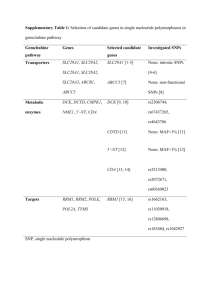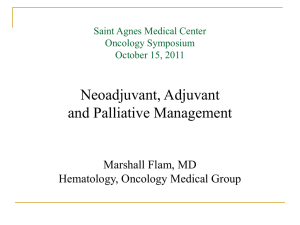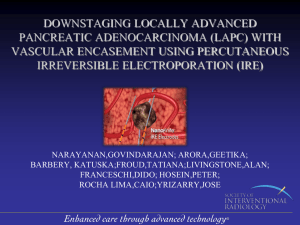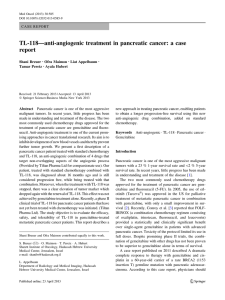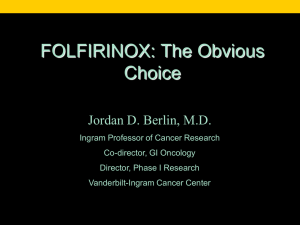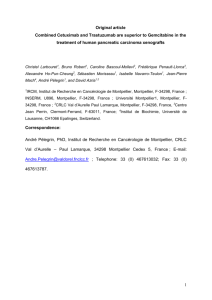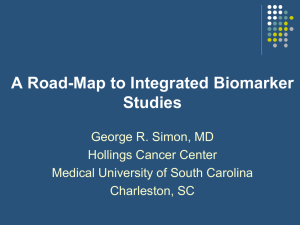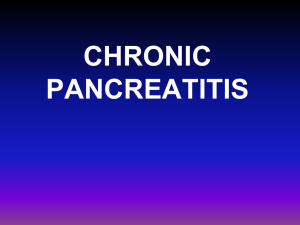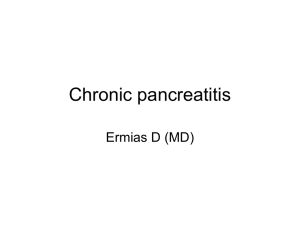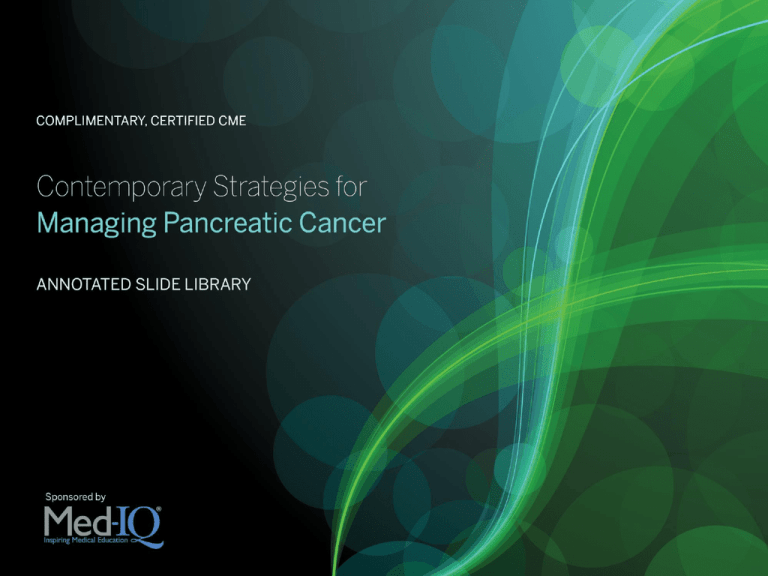
Faculty
Caio Max S. Rocha Lima, MD
Professor of Medicine
Co-Leader, Colorectal, Pancreatic, Liver, and
Related Cancers Group
Co-Director, Phase I Unit
University of Miami
Leonard M. Miller School of Medicine
Sylvester Comprehensive Cancer Center
Miami, FL
Activity Planners
Shari J. Dermer, PhD
Manager, Educational Strategy and Content
Med-IQ
Baltimore, MD
Lisa R. Rinehart, MS, ELS
Director, Editorial Services
Med-IQ
Baltimore, MD
Pancreatic Cancer: Statistics
• 45,220 new cases estimated in 2013
• 38,460 deaths from pancreatic cancer estimated in 2013
• > 50% of cases are metastatic at diagnosis
6.0% 5-year
survival rate
from 2003 to 2009
Number per
100,000 Persons
15 —
Localized (9%)
10 —
Confined to primary site
New Cases
Deaths
Regional (27%)
Spread to regional
lymph nodes
5—
Distant (53%)
0 —|
1992
Cancer has metastasized
|
1995
|
2000
|
2005
Time From Induction, months
|
2010
Unknown (11%)
Unstaged
www.SEER.cancer.gov.
Oncogenes
• KRAS mutations1
– Very common (> 90%), usually restricted to codon 12
– Early genetic event in pancreatic carcinogenesis and
are considered to be a “signature” of pancreatic cancer
• BRAF mutations2
– Observed in 30% of the pancreatic cancers with WT
KRAS gene
• AKT1 gene, AKT2 gene, and MYB gene amplification
– Observed in 60%, 10% to 15%, and 10% of pancreatic
cancers, respectively3-5
1. Almoguera C, et al. Cell. 1988;53:549-54;
2. Kanda M, et al. Gastroenterology. 2012;142:730-3;
3. Li D, et al. Lancet. 2004;363:1049-57;
4. Cheng JQ, et al. Proc Natl Acad Sci USA. 1996;93:3636-41;
5. Wallrapp C, et al. Cancer Res. 1997;57:3135-9.
Tumor Suppressor Genes
• Inactivation of the p16 gene1
– Observed in 80% to 95% of sporadic pancreatic cancers
• The combination of p16 and KRAS mutations is
uncommon in other human tumors and is considered to be
a molecular “signature” for pancreatic cancer
• Observed at a later stage in pancreatic carcinogenesis
than KRAS mutations
• p53 gene inactivation2
– Observed in 55% to 75% of cases and is a late event in
tumorigenesis
• p21 gene inactivation
– Early event in the development of pancreatic carcinoma
1. Schutte M, et al. Cancer Res. 1997;57:3126-30.
2. Li D, et al. Lancet. 2004;363:1049-57.
Tumor Suppressor Genes
• SMAD4 gene1
– Plays a critical role in signaling through the TGF-beta pathway
and occurs in about 55%
• BRCA2 (her-2/neu)2
– Gene mutation carriers have a 10-fold increased risk of
developing pancreatic cancer
– Prognostic and may play a role in adjuvant, neoadjuvant, and
chemoXRT approaches
1. Ghaneh P, et al. Gut. 2007;56:1134-52.
2. Bachet JB et al. Ann Oncol. 2012; 23: 2327-35.
Molecular Features and Risk of Relapse
• SMAD4
– Poor prognosis1,2
– Pattern of relapse3,4
•
•
•
•
CXCR45
Notch/hedgehog6
Stromal SPARC7-9
Cancer stem cells6
1. Kojima K, et al. Cancer Res. 2007;67:8121-30;
2. Blackford A, et al. Clin Cancer Res. 2009:15:4674-79;
3. Iacobuzio-Donahue CA, et al. J Clin Oncol. 2009;27:1806-13;
4. Crane CH, et al. J Clin Oncol. 2011;29:3037-43;
5. Bachet JB, et al. Ann Oncol. 2012;23:2327-35;
6. Hezel AF, et al. Genes Devel. 2006;20:1216-49;
7. Infante JR, et al. J Clin Oncol. 2007;20:319-25;
8. Neuzillet C, et al. Cancer Metastasis Rev. 2013;32:585-602;
9. Sinn M, et al. J Surg Oncol. 2013;108:398-402.
NCCN Definitions: Locally Advanced and
Borderline Resectable
• Locally advanced
– SMA encasement > 180 degrees
– Unreconstructable SMV/portal vein occlusion
– Any celiac abutment (head) or celiac encasement > 180
degrees (body/tail)
– Aortic invasion or encasement
– Lymph node metastases beyond field of resection
• Borderline resectable
– SMA encasement < 180 degrees
– SMV/portal impingement
– Short-segment SMV occlusion
– Celiac encasement < 180 degrees (tail)
– Abutment/encasement of hepatic artery
NCCN Guidelines. Pancreatic Adenocarcinoma V1.2013;
Varadhachary GR. J Gastrointest Oncol 2011;2:136-42.
Chemo Alone vs. Chemo-RT
Chemo
No. of
Patients
Median
Survival
(Mos)
1-Year
Survival (%)
40
5-FU
5-FU
47
44
8.3
8.2
28
31
GITSG 92832
54
5-FU & SMF*
SMF*
22
21
9.7
7.4
41
19
FFCD-SSRO3
60
5-FU & Cis*
Gemcitabine
59
60
8.6
13
32
53
ECOG 42014
50.4
Gemcitabine
Gemcitabine
34
37
11.0
9.2
50
32
Study
Radiation
(Gy)
ECOG1
*Investigational
1. Klaassen DJ, et al. J Clin Oncol. 1985;3:373-8;
2. GITSG. J Natl Cancer Inst. 1988;80:751-5;
3. Chauffert B, et al. Ann Oncol. 2008;19:1592-9;
4. Loehrer PJ, et al. J Clin Oncol. 2011;29:4105-12.
FOLFIRINOX* Experience in LAPC
Age
Sex
Median (range)
n (%)
57.5 (41-73)
Male
Female
10 (56%)
8 (44%)
0
1
8 (44%)
10 (56%)
Head
Uncinate process
Body
Tail
11 (61%)
3 (17%)
2 (11%)
2 (11%)
Yes
No
9 (50%)
9 (50%)
SMA encased
HA encased
Celiac trunk encased
Confluence of PV, SV and
SMV encaed
SMV encaed
SV encased
3 (17%)
2 (11%)
3 (17%)
ECOG Performance Status
Pancreatic tumor location
Biliary stent
Basis for unresectability
*Investigational use.
5( 28%)
4 (22%)
1 (6%)
Hosein P, et al. BMC Cancer. 2012;12:199.
A
FOLFIRINOX* Outcomes
in
LAPC
B
14 patients
FOLFIRINOX
(3-12 cycles)
1 progressed
after 3 cycles
4 patients
FOLFIRINOX
(6-17 cycles)
4 resectable by imaging
2 R0 resections
1 R1 resection
1 unresectable at E-lap
9 unresectable
at maximum
response or
tolerability
Combined
chemoradiation
(2 ongoing)
3 post-op
combined
chemoradiation
1 post-op
observation
3 resectable
by imaging
3 R0
resections
4 still
unresectable
Patient flowchart for patients assessed as having unresectable disease (panel A, n =
14), and for those assessed as having borderline resectable disease (panel B).
3 resectable by imaging
3 R0 resections
1 unresectable
at maximum
response or
tolerability
3 post-op
combined
chemoradiation
Combined
chemoradiation
1 still
unresectable
*Investigational use.
Hosein P, et al. BMC Cancer. 2012;12:199.
LAPC: Conclusions
• XRT + chemotherapy better then XRT alone
• Gemcitabine + XRT is potentially superior to
gemcitabine alone
– The ECOG study had poor accrual and closed
early
• Retrospective data: chemo followed by
chemoXRT superior to chemoXRT upfront
– The role of XRT in LAPC is questioned due to
the results of the LAP 07 study
• Gemcitabine may be a superior radiosensitizer to
5-FU
• The role of FOLFIRINOX in the neoadjuvant
setting is emerging
International Phase 3 Trial
Pancreatic cancer
(metastatic)
Gemcitabine 1,000 mg/m2
IV weekly x 7 of 8
Gemcitabine 1,000 mg/m2
+
Nab-paclitaxel 125 mg/m2
weekly x 3 of 4
Von Hoff DD, et al. N Engl J Med.2013;369:1691-703.
Phase 3 Trial:
Gemcitabine and Nab-Paclitaxel
Nab-Pac
Gemcitabine
n = 431
Gemcitabine
n = 430
HR
P value
OS, median
8.5
(7.89-9.53)
6.7
(6.01-7.23)
0.72
(0.617-0.835)
0.000015
1-year OS %
35
22
-
0.0002
PFS median
5.5
(4.47-5.95)
3.7
(3.61-4.04)
0.69
(0.581-0.821)
0.000024
23
7
-
Outcome
RR %
Von Hoff DD, et al. GI Cancers Symposium 2013[Abstract LBA148].
PRODIGE 4—ACCORD 11 Trial Design
Metastatic
pancreatic
cancer
R
A
N
D
O
M
I
Z
E
For both arms:
FOLFIRINOX*
Gemcitabine
CT scans:
obtained
every 2 months
6 months of
chemotherapy
recommended
Stratification:
• Center
• PS: 0 vs. 1
• Location of the tumor: head vs. other location of the primary
tumor
*Investigational use.
Conroy T, et al. N Engl J Med. 2011;364:1817-25.
PFS
Gemcitabine
Probability
1.00
FOLFIRINOX
HR = 0.47, 95% CI (0.37-0.59)
0.75
P < 0.0001
0.50
Median PFS FOLFIRINOX: 6.4 mos
Median PFS gemcitabine: 3.3 mos
0.25
0.00
0
3
6
9
12
15
18
21
24
27
30
33
36
0
1
0
1
0
0
0
0
0
0
0
0
Months
Number at risk
Gemcitabine 171 88 26
FOLFIRINOX 171 121 85
8
42
5
17
2
7
0
4
Reprinted with permission from Conroy T, Desseigne F, Ychou M, et al. FOLFIRINOX versus
gemcitabine for metastatic pancreatic cancer. N Engl J Med. 2011;364(19):1817-1825.
Acknowledgement of Commercial Support
This activity is supported by educational grants from
Bayer HealthCare Pharmaceuticals, Onyx
Pharmaceuticals, Celgene Corporation, Daiichi
Sankyo, Inc., and Lilly. For further information
concerning Lilly grant funding visit
www.lillygrantoffice.com
Copyright
© 2014 Med-IQ®. All rights reserved.

